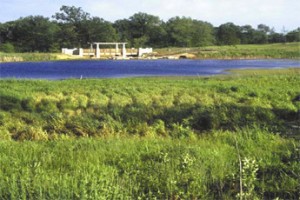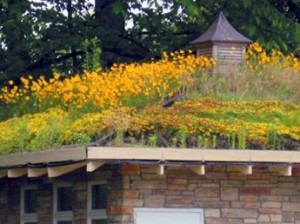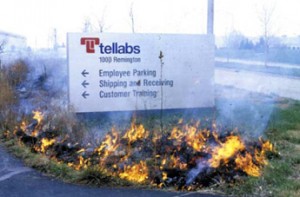Native Landscaping
Key to plant community restoration is that cultures make choices with respect to their relationship to the Earth. It is hoped that the relationship is felicitous for all the other living things native that reside under their care. Their choices must be informed by observations on the health and well being of all of God’s creatures. If we care for them, they will care for us.
Through the care and stewardship of plants indigenous to this area, we can provide sacred places for visitors, even as the Earth begins to heal. It is here at the Annunciation Mother of God Byzantine Parish that we accept our covenant with the Lord to take care of the
“fish of the sea, … the birds of the air, … and every living thing that moves upon the earth … and everything that has the breath of life.” It is for this that we were created, male and female, on the sixth day. Genesis 1:26-30.
Annunciation Parish will be a place where the landscape is alive, plants will reproduce, and stewards will be taught to hear and understand the landscape. Over many years and with proper stewardship, these ecosystems will provide diverse habitats and seed sources for future landscapes within and around Homer Glen.

A wet prairie at Coffee Creek in Chesterton, IN
Prairie
The word prairie is the French deviation from the Latin word for “pratum”, which means “meadow.” It was first applied to the open, grass-covered, treeless landscapes discovered in America by the early French explorers. The prairie landscape at Annunciation Parish will be a de novo reconstruction all across the site, with varying degrees of moisture ranging from dry to wet. When established, the vegetation will consist of native grasses and forbs that will form extensive root systems – a condition that will increase infiltration of precipitation, reduce or eliminate runoff, filter pollutants, and recharge the groundwater system. The annual ritual of controlled burn management is also critical to the success of the prairie landscape.
Permeable Pavement
Permeable paving is proposed for the entire parking area and is meant to replace the existing asphalt surface. One objective of durable, long-lasting permeable paving is to provide direct infiltration of rainwater and thus eliminate surface water runoff from the parking facility into the adjacent detention areas. The “first flush” of water that comes off of a paving surface quite often carries with it the dirtier, more polluted water. Passage through the permeable pavers and its associated base and sub-base, enables this initial water to be cleansed, cooled, and infiltrated into the ground. In cases where there is too much rainfall to be absorbed fully, water will run into adjacent infiltration trenches or swales vegetated with native plants, which also have a high infiltration capacity. These swales can be incorporated directly into the parking lot or may run along the perimeter. In extreme storm events, the water in the swales overflows to the naturalized detention area and assures that the parking lot does not become waterlogged.
A “green roof” typically consists of an engineered soil and drainage medium inhabited by drought-tolerant vegetation such as sedums, grasses, and a few hardy perennials. One benefit of a green roof is its ability to increase the insulating value of a building which can reduce heating and cooling bills and adds significantly to the life of the roof. Traditional rooftops exposed to solar radiation are disposable roofs. Ten to fifteen years is an average life for a roof in Chicago. Solar rays degrade materials, as does rapid and excessive heating and cooling of the roof materials. The drainage material, soil, and vegetation of a green roof help significantly to temper rapid changes in temperature and eliminate the exposure to light rays, which can extend the life of the roof. Green roofs also provide significant value to the environment. The vegetation not only consumes rainwater for plant growth, thus reducing storm water facilities, but transpires moisture back into the atmosphere to cool summer temperatures.

Typical rooftops generate significant rainwater runoff, green roofs; in contrast, can reduce rainwater runoff by up to seventy percent or more on an annual basis. Even a green roof with only 3 inches of soil can regularly absorb most rainfall events. Across the face of northeastern Illinois, every acre of green roof equates to five to eight hundred thousand gallons of water annually that will never leave the roof system in the form of surface water runoff.
Ornamental Landscape
Each garden will be a highly ornamental landscape that has a tremendous amount of color, texture, movement, and aroma that will change and be comely for all four seasons. The plant arrangements will complement one another and be the perfect backdrop for the various water features and terraces.
IMPLEMENTATION
The implementation of Phase I is the beginning of a strategy to realize the Landscape Master Plan vision. The first phase of change will look at restoring native landscapes to a large portion of the site, especially around the existing pond and the areas that receive off-site stormwater. The detention areas for the church no longer will be mowed except for once a year after the 15th of July so as to not disturb groundnesting birds. This will result in an attractive, Old World meadow replete with numerous bird species. Until on-site stormwater is managed properly, there is little chance for survival of a native landscape in these areas.
This portion of work will be perceived as a noticeable change to those that pass the church regularly and will be a signal that the church is being proactive when it comes to healing the earth. It will reduce, substantially, the need and cost for conventional lawn care, which in turn will reduce the output of harmful emissions into the air from lawn care equipment.

A prescribed burn at Tellabs in Bollingbrook, IL
Additional phases have been outlined on the accompanying graphic with the understanding that phase lines may change with the availability of funds. Phase II is anticipated to include a green roof on the existing porte cochere, retrofit of the asphalt parking to permeable paving in this general vicinity, and the inclusion of a rain garden at the main entry to the church. Phase III may be the development of a nature park and trail system in the detention basin that serves the adjacent residential neighborhood and abuts the church property. As this piece is developed, additional trails will be implemented on the church property to allow for church members and visitors alike to walk the property while immersed in a native landscape.
One element of the Landscape Master Plan that will be ongoing through all phases of work will be to monitor and augment the various ecosystems proposed for the site. Because site influences change, so too will the landscape.